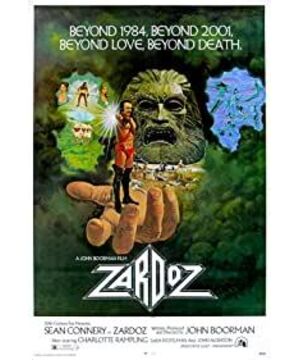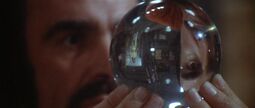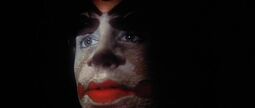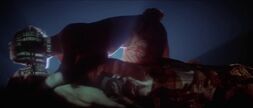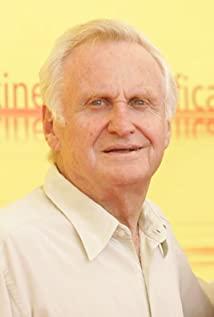History and the death wish:
Zardoz as open form
by Fredric Jameson
from Jump Cut, no. 3, 1974, pp. 5-8
copyright Jump Cut: A Review of Contemporary Media, 1974, 2004
Does ZARDOZ mean anything? And even if it does, even if we manage to disengage some relatively coherent “statement” from this complicated entanglement of plot and image, is it just possible that such a statement or message might be diluted beyond all recognition by the medium's own sensory overload? Is it possible, in other words, that conceptual meaning knows some weakened status in the movie house, compared to the authority it exercises in a purely verbal text? Are abstract ideas, somehow neutralized by the weight of the present and the intensity with which we stare at the sheer narcotic flux of the screen's materials?
If we think about ZARDOZ in a “literary” way, at any rate, the action of the film is evidently designed to make two distinct philosophical points, not necessarily related to each other. On the one hand, Boorman seems to have set out to redramatize an idea of religion essentially developed by Enlightenment thinkers: namely, that all religious belief is a superstitious mystification perpetuated by a cruel and repressive apparatus of priests and oppressors. Think, for instance, of the Marquis de Sade's remark, characteristic of the whole Age of Reason in this respect: “The invention of the idea of God is the only crime I cannot find it in myself to pardon mankind.So Zed's murder of the “puppet master”—which at first strikes us as the bloody lust to destroy an ignorant savage—little by little comes to take on the heroic value of a gesture of human liberation.
Yet what is tantalizing and “estranging” about Boorman's version of the theme is the way in which, in his vision of a distant future which has forgotten its own past, alongside the great forerunners in the battle against the infâme, alongside Voltaire and the Encyclopédie , the dog-eared illustrated pages of the Wizard of Oz itself take their place! A quite different notion of the virulence and the unexpectedly active revolutionary power even of such a very modest cultural artifact than in Kubrick's cynical demonstration in A CLOCKWORK ORANGE, of the indifferent reinforcement by classical music of whatever activity it happens to be associated with rape, murder, torture and the like. (It is true that in both films there is an implicit rebuke to “high” bourgeois culture—the stuffy image of the Beethoven bust is invoked in the service of the inhumane,while genuine enlightenment emerges, not from the great philosophers and poets, but from a chance reading of J. Frank Baum.)
I suppose that in the relatively secularized world of US capitalism, with its denominal “tolerance” and its anodyne Protestant sects, the attack on superstition may be difficult to recognize for the revolutionary powerful motif it has been throughout Western history, in the emergence of a secular middle-class state from the pre-rationalistic values of the feudal era. Its practical lesson is inscribed, indeed, not in recent US experience, but in the sorry failures of national and revolutionary movements in our own time from Ireland to Islam, which have shaken off foreign domination only to remain the voluntary prisoners of their own backward and ignorant local religions. In countries like these, the anticlerical passion, the struggle against the habits of hierarchy and obedience taught by religious doctrines, is a life-and-death issue.But in the United States it seems a dim memory, anachronistically evoked in ritualistic debates about federal aid to parochial schools. Yet I would think that the very real power of this part of Boorman's film can be fully appreciated only when understood as part of that older Enlightenment tradition. Only think of the stone head itself, as it hovers over groveling populations, soaring against a vacant blue sky like the very revelation of the sacred itself in some simplified and more fundamental universe.as it hovers over groveling populations, soaring against a vacant blue sky like the very revelation of the sacred itself in some simplified and more fundamental universe.as it hovers over groveling populations, soaring against a vacant blue sky like the very revelation of the sacred itself in some simplified and more fundamental universe.
This theme is thus progressive, but it is attenuated in its ideological effect. Neither of these things can be said about ZARDOZ's other major thesis, namely the alleged relation between nature and morality, and the claim that human beings need death in order to realize some genuinely human existence. This thought, however doubtful its ideological connotations, can boast whatever degree of philosophical respectability you may desire, from Heidegger's “being-unto-death” to Robert Ardrey's assertion of man's killer instinct. Here we have a dramatization of that motto from the Satyricon which Eliot used as his motto for The Waste Land:
“I once saw the Sybil of Cumae hanging in a bottle, and when the boys asked her, 'Sybil, what do you want?' she said, 'I want to die.'”
Myth critics of the Frye persuasion will certainly find other versions in the tradition for this archetype, which lies somewhere between the legend of the Wandering Jew (with its literary examples all the way to Swift's Struldbrugs, Melmoth the Wanderer and Simone de Beauvoir's Tous les hommes sont mortels) and the notion of a Götterdammerung-style collective euthanasia. We may, however, want to take a less belle-lettristic attitude towards the present variation on this theme. Remember that, before making ZARDOZ, Mr. Boorman lent himself to a lavish production of that sermon in backwoods self-reliance which is James Dickey's Deliverance. It is a cautionary tale for a soft and citified US bourgeoisie which therein is warned about the urgency of self-defense in a world not uniformly well disposed to suburbia. It is true that Mr. Boorman,possibly out of embarrassment, tried to correct the perspective of his text by making his heroes more distinctly antipathetic than they were in the novel. He also added the banjo session, in which a positive side of hillbilly culture was underscored, and a kind of compromise meeting ground between the two sides at least temporarily arranged. Still, DELIVERANCE's moral suggests that this aspect of ZARDOZ needs a harder and more suspicious look than anything myth criticism is capable of. It also reminds us of our opening question, namely, what relation a movie's conceptual or ideological content ought to have to that more general sensory experience which it embodies and to the ultimate value we may want to assign it as a work of art.tried to correct the perspective of his text by making his heroes more distinctly antipathetic than they were in the novel. He also added the banjo session, in which a positive side of hillbilly culture was underscored, and a kind of compromise meeting ground between the two sides at least temporarily arranged. Still, DELIVERANCE's moral suggests that this aspect of ZARDOZ needs a harder and more suspicious look than anything myth criticism is capable of. It also reminds us of our opening question, namely, what relation a movie's conceptual or ideological content ought to have to that more general sensory experience which it embodies and to the ultimate value we may want to assign it as a work of art.tried to correct the perspective of his text by making his heroes more distinctly antipathetic than they were in the novel. He also added the banjo session, in which a positive side of hillbilly culture was underscored, and a kind of compromise meeting ground between the two sides at least temporarily arranged. Still, DELIVERANCE's moral suggests that this aspect of ZARDOZ needs a harder and more suspicious look than anything myth criticism is capable of. It also reminds us of our opening question, namely, what relation a movie's conceptual or ideological content ought to have to that more general sensory experience which it embodies and to the ultimate value we may want to assign it as a work of art.and a kind of compromise meeting ground between the two sides at least temporarily arranged. Still, DELIVERANCE's moral suggests that this aspect of ZARDOZ needs a harder and more suspicious look than anything myth criticism is capable of. It also reminds us of our opening question, namely, what relation a movie's conceptual or ideological content ought to have to that more general sensory experience which it embodies and to the ultimate value we may want to assign it as a work of art.and a kind of compromise meeting ground between the two sides at least temporarily arranged. Still, DELIVERANCE's moral suggests that this aspect of ZARDOZ needs a harder and more suspicious look than anything myth criticism is capable of. It also reminds us of our opening question, namely, what relation a movie's conceptual or ideological content ought to have to that more general sensory experience which it embodies and to the ultimate value we may want to assign it as a work of art.what relation a movie's conceptual or ideological content ought to have to that more general sensory experience which it embodies and to the ultimate value we may want to assign it as a work of art.what relation a movie's conceptual or ideological content ought to have to that more general sensory experience which it embodies and to the ultimate value we may want to assign it as a work of art.
We should begin by noting that the presence of History is not so strong in ZARDOZ as it is in science fiction of the “near future type (eg, the 1984-type dystopia, SOYLENT GREEN). Boorman's film, indeed, seems to hesitate between a future history of a henceforth conventional kind—which dramatizes the human race's survival after the atomic cataclysm, the rebuilding of civilization, the survival of knowledge, or the return of mankind to the savagery of some dark ages. Or it may offer instead an atemporal fable of the appearance-reality variety, something on the order of, say, THE MAGNUS, which seems to have left its traces here in the (to me) tiresome puppet master/ magician, with his annoyingly self-conscious winks at the audience.
Yet History can nonetheless be felt in the splendid opening sequences—less in the implied distance between our own present and this projection of a distant future some three centuries hence than in the cross cutting from one landscape of this future world to another. For by the time of Zardoz, the human race is supposed to have evolved along in two separate and independent lines of development. On the one hand, there's the “outlands,” with their feudal structure and their return to barbarism, their hooded horsemen and helpless population put to sword and flame. On the other, ZARDOZ opposes a vision of a post-technological Utopia, a commune of leisure and super-science whose inhabitants have chosen, for hygienic reasons, to perform their own manual tasks. These sequences are marked with a curiously pastoral, anachronistic character.We see future machinery erected within the rural peacefulness of the British countryside, historic abbeys outfitted with wonderworking equipment shrouded in transparent plastic, unpolluted Irish woods and ponds among which the immortals, in their Grecian vestments and ancient Egyptian headdresses, discreetly wander. This village enclave , indeed, provides us with some spectacular Godard-like solid colors and painted walls, recalling Stanley Cavell's idea (1) that color, in film, far from being an added instrument in conveying reality, is in fact a means of transmuting the given, a device of Utopian transfiguration.in their Grecian vestments and ancient Egyptian headdresses, discreetly wander. This village enclave, indeed, provides us with some spectacular Godard-like solid colors and painted walls, recalling Stanley Cavell's idea (1) that color, in film, far from being an added instrument in conveying reality, is in fact a means of transmuting the given, a device of Utopian transfiguration.in their Grecian vestments and ancient Egyptian headdresses, discreetly wander. This village enclave, indeed, provides us with some spectacular Godard-like solid colors and painted walls, recalling Stanley Cavell's idea (1) that color, in film, far from being an added instrument in conveying reality, is in fact a means of transmuting the given, a device of Utopian transfiguration.
These two modes of life are of unequal difficulty aesthetically. That of the reversion to barbarism is no doubt the easiest to convey, and the most powerful and suggestive. ZARDOZ's opening sequences recall that electrifying first glimpse of the masters of the PLANET OF THE APES on horseback, driving their servile population of former humans before them through the fields. Masks and horses: suddenly Marc Bloch's attribution to the latter of the entire feudal power structure (2) takes on a deeper and more fundamental symbolism. The images of horsemen on the strand, of hooves galloping through the foam on the edges of the sea itself, exercise a powerful atavistic fascination on the modern mind. It's as though they were sweeping a world free of the detritus of marinas and motels, of pleasure boats and gas stations,and returning us to a harsher nature in which man nonetheless—owing to his mount!—plays a more commanding and active role than is assigned him in what we call civilization.
The vision of our civilized order's collapse, indeed, touches a receptive chord in anyone's imagination. It awakens some of those same fantasies and anxieties which DELIVERANCE also set out to manipulate. This particular future-history convention, the disappearance of civilization after a historic catastrophe , the reversion to Neolithic life, or feudalism, or isolated food-gathering tribal units, is not necessarily the unalloyed nightmare it may at first seem. It relieves us, indeed, of the obligations of civilization as well, of the burden of repression inherent in the latter, of which Freud's Civilization and its Discontents is the classic statement. The end of the world is a1so the end of this particular world of US monopoly capitalism. As such, the possibility can be just as much a wish fulfillment as a source of alarm; in the event, I think,are both at once, in the unity of a single complex and ambivalent fantasy line.
Yet, even the negative aspect of this convention is perhaps more complicated than we may be tempted to think. Obviously, its first implication is a radically personal one, raising the fundamental question about our survival in such an altered universe. It causes us to wonder whether we ourselves would have had the know-how and the ruthlessness to adapt to more primitive conditions and demands. DELIVERANCE's original sin, from an ideological point of view, was to have tried to allay this anxiety and to have answered this question, to have provided a formula apt to satisfy the self questionings of the bourgeois public. In this sense DELIVERANCE was a cheap wish fulfillment with hidden political motive. It tried to suggest that people like us (read: the US middle classes) can really be counted on,when the chips are down and in spite of our woeful physical preparation, to win out and smite our enemies. ZARDOZ, by transposing the entire issue into future history, eliminates at least this immediate local class reference. It apparently divests the fantasy of its ideological implications (although whether this can ever really be completely achieved we will try to determine later on).
ZARDOZ's strength, in this respect, lies in the ambiguity of its main character, who is both stronger and stupider than we are (a barbarian, with barbaric ruthlessness and impulses) but also more intelligent and ultimately more resourceful and imaginative than his Utopian captors. He is not therefore a hero in the usual sense of a model for behavior, but rather something closer to a device for capturing and holding our fantasy investment. Sean Connery's heavy features have indeed rarely been so expressive in their basic inexpressiveness. Scowls, blank looks , a raised eyebrow or a sudden sharp light in the eye, the most economical gestures are here charged with density of meaning, with the accumulated reactions of a whole character structure. It is good to see this actor used to better effect than in the vacuity of the Bond movies,for whose sophisticated banter his facial equipment was far too ponderous (Roger Moore is much more suitable). Connery's gift is rather that of the physical orchestration of sarcasm, of contempt, of glacial indifference, of the type which, before this, he was given to manifest in Kalatazov's admirable RED TENT. There, Amundsen's arrogance and disdain finally met a worthy adversary in death itself. In the icy wreckage of the dirigible, among corpses as though immobilized for an instant at their various occupations, doomed, he calmly prepares himself for his fate, meeditatively opening a stray volume in order to while away the final minutes of life.of the type which, before this, he was given to manifest in Kalatazov's admirable RED TENT. There, Amundsen's arrogance and disdain finally met a worthy adversary in death itself. In the icy wreckage of the dirigible, among corpses as though immobilized for an instant at their various occupations, doomed, he calmly prepares himself for his fate, meditatively opening a stray volume in order to while away the final minutes of life.of the type which, before this, he was given to manifest in Kalatazov's admirable RED TENT. There, Amundsen's arrogance and disdain finally met a worthy adversary in death itself. In the icy wreckage of the dirigible, among corpses as though immobilized for an instant at their various occupations, doomed, he calmly prepares himself for his fate, meditatively opening a stray volume in order to while away the final minutes of life.Meditatively opening a stray volume in order to while away the final minutes of life.Meditatively opening a stray volume in order to while away the final minutes of life.
What, indeed, is the star system good for, if not to offer so many diverse physical forms in which our various reactions find appropriate objectification? Projected outward and manifested in something a little more complex than what has been called empathy or identification, our own fleeting emotions and feelings find themselves endowed each with a complete individuality of its own. Our feelings are lent the stylistic homogeneity of, say, erotic humor, or defenselessness, or rage, or nerves—each insubstantial nuance of our own being-in-the -world made flesh and labeled with the name of an actor, contemplated with a complacency in which the very secret of the movies as a form lies buried. So here there is something touching about the use of Connery's muscular body, among the sexless androgynous creature creatures of the Vortex,as a very symbol of human frailty and mortality.
As for his adversaries among the Utopians, the men, at least, are surely meant to dramatize the opposite of the body itself, a kind of angelism of which the sex organs' atrophy is both symptom and symbol. The aesthetic problem here is that Boorman has judged his Utopia from the outset and condemned it to destruction. Thus he deprives the film of some more interesting and ambiguous tension between the demands of life and the consequences of perfection. In this hostility to the Utopian impulse, Boorman is of course not alone . On the contrary, it is characteristic of the entire West today, whose dominant convention in this realm is rather the dystopia, Utopia gone wrong like some nightmare of berserk machinery. In dystopia all the features of order are mustered to create the ultimate straitjacket for the human instincts, if not the human spirit.But we should take into consideration the possibility that this repugnance of our society for the Utopian vision may itself be an ideological symptom rather than a genuine historical and ontological recognition. Marcuse is, indeed, only the most recent to have denounced the anti-utopian inclination of our society as a key feature in its repressive apparatus and structure. It seems to me axiomatic that the refusal of Utopia—whatever motivation is given (eg, excessive rationalization, atrophy of the physical, planification and totalitarianism)—is always a code word or disguise for refusing socialism. The anti-utopian strategy has as its function to eliminate from the outset the possibility of any speculation about human possibilities and the transformation of the social order.It forestalls the kind of thinking which would explain the present society's imperfections and injustices as the result of history and human action, rather than as the reflection of some immutable and constitutionally defective human nature. Not that Boorman has anything original to add to this strategy, which begins to be elaborated with the Soviet revolution (We, Brave New World) and knows its climax in the US apologists of tie Cold War. But his film works within its conventions and thus serves, if nothing else, as to contribute to its reinforcement .Brave New World) and knows its climax in the US apologists of tie Cold War. But his film works within its conventions and thus serves, if nothing else, as to contribute to its reinforcement.Brave New World) and knows its climax in the US apologists of tie Cold War. But his film works within its conventions and thus serves, if nothing else, as to contribute to its reinforcement.
The classical representation of the opposition between barbarism and Utopia, or between degenerated versions of each, is however to be found in HG Wells' The Time Machine (1895), a work which, in its deliberate and cynical demystification of such 19th century idealistic Utopias as Bellamy's Looking Backward, may be said to represent something like the climax of 19th century speculation on the nature and future development of the industrial class system. In Wells, of course, the weak and pitiful Eloi have become the victims of the grim Morlocks, who live and work beneath the earth and emerge at night to prey on the descendents of their former rulers. In ZARDOZ, this process has not yet gone so far. Boorman's sexless “Eloi” are still able,through the use of religion and the establishment of a kind of mercenary army of the classical Lumpenproletariat type, to control otherwise dangerous “lower classes” and to use the latter's labor to establish for themselves an oasis of leisure and privilege.
But the inhabitants of Boorman's Vortex are a ruling class of a particular type. They are drawn principally from the scientific elite, whose discoveries and technological know-how have made this new Utopia possible. Thus another possible interpretation or decoding would read the film as a fable of the University itself, as the spectacle of a realm isolated from the surrounding culture, of intellectuals as unsuccessful candidates for some projected new race of supermen, and their ivory tower as the spoils of the barbarians who break in upon them to destroy it.
In this respect, ZARDOZ redramatizes another familiar theme of science fiction, which is worth pausing on for a moment, namely the hypostasis of the cultural tradition as such. Such a theme depicts the pathos of a new intellectual dark ages, and the burning of the books, the vision of a rebirth of civilization from the monastic manuscripts and the like. Indeed, books themselves have always played an important role in science fiction, but in a somewhat different way from that more familiar way in high culture where we so often find novels written about novels and in general literature which signifies literature itself. I am not at all convinced that science fiction is really about science, nor even that scientific elements or ideology loom very large in it. (The example of Jules Verne would suggest, indeed ,that technology and engineering are the more basic models, if models of this type are sought.) It is certain that the overvaluation of the Library as such is a reflex of the technological orientation. (It is part of the whole complex of values of idealistic liberalism, with its emphasis on reeducation and on education proper, and, to return to our opening theme, in general on enlightenment.) It is essential to preserve the books, not because, as in “high” literature, there is some privileged value seen in writing and inscription in general, but because books contain the secret of the machines. The manual gives the plan of Brian Aldiss' Starship while the starship's log tells the story of the disaster that resulted in a new dark ages for its passengers. More explicitly, the classics of “future history” all in one way or another sound this theme.The canonical treatment is surely Walter Miller's Canticle for Leibowitz, in which a priestly caste of intellectuals preserves scientific documents and know-how against iconoclastic and book-burning barbarians. The latter theme is of course the very subject of Bradbury's Fahrenheit 451, while the Strugatsky Brothers' Hard to be a God gives a picture the same archetypal “dark ages” from the standpoint of the tradition of Soviet science fiction. My own suspicion is that this henceforth conventionalized theme amounts to the worst kind of ideological vested interest on the part of intellectuals themselves, even of those who might otherwise feel a little shame at this self-serving status apologia, but who may well be willing to sacrifice such personal reluctance in the name of the survival of Culture itself. Much more palatable are those Utopias,from William Morris to Phil Dick, which are conceived in terms of handicraft and manual labor, the return to the rudiments of village production as a kind of implied rebuke to the passive consumption encouraged by commodity capitalism (elements also present in rudimentary form, as we have seen in ZARDOZ). Even though such visions are themselves anachronistic, insofar as they are ultimately inspired by an older archaic stage in the development of the economic system to which we can scarcely hope to return, their very ideologies redolent of the handicraft radicalism of tinkers and village shoemakers, the politics of Bunyan and Blake, let alone of the twenty-first or -second century. Yet the emphasis on labor rather than on knowledge amounts to a glorification of the Slave rather than the Master,of village industry rather than of that priestly caste whose monopoly on writing and books, as Lévi-Strauss suggests, was at the very origins of class society and of political domination.(3)
Still, I must admit that I like Boorman's version of the ultimate library better than the sentimentalized ambulatory classics of Bradbury and Truffaut. There is something tantalizing, indeed, about these Arcimbaldo-like human forms marbled over by the very raw materials of culture itself, with equations and molecules, script and cartographic projects, torsos, busts, and whole statues convex with scientificity, plastic glimpses of flesh transmuted into the very codes of knowledge, succeeding themselves in a revolving pan shot against the black void of the turning screen itself. (It is doubly amusing, then, that this supreme knowledge should come to the hero as the other end of an exchange of all he has to offer in return, namely emissions of fresh and healthy sperm cells.)
This is the moment, perhaps, to press our initial question a little more insistently. We shoul try to determine what connection there is, if any, between Boorman's “ideology”—if that is the right word for the conceptual content of ZARDOZ—and his purely filmic visual composition. The film, which has inevitably been compared to Kubrick's 2001: A SPACE ODYSSEY, seems to me much closer in general narrative spirit to movies like Fellini's SATYRICON. (To reawaken a dead world is as “speculative” as the projection of a future one, it is an enterprise we might characterize—think of Golding's Inheritors—as archeological science fiction.)
The visual features of 2001 were, on the one hand, the screen as a surface to be inscribed, and on the other, the window-cockpit traveling across an expanse of landscapes. So its great events were moments like that in which the “life lines” of the sleeping crew members gradually flattened out into death's static linearity (here the screen functions as an instrument panel, or the registering apparatus of a seismograph or an EKG). Or that in which the computer HAL is dismantled, circuit by circuit ( the visual sequence of lights being extinguished here reduplicated by the successive decomposition of the computer's voice as well). Or again, like the slow approach or rapid tumbling disappearance of the body of the dead astronaut in space, encased in the cocoon of his cumbersome space suit.Or the final dizzying flight over some hallucinogenic Arctic of colors beyond the normal range of human eyesight. ZARDOZ is no match for moments like these, in which we are spectators seated comfortably in the speeding vehicle of a movie theatre soaring into infinity. But to Kubrick's reaffirmation of the flatness of the visual screen, Boorman has his own distinctive effects to oppose, and notably the concept of the visual field as a plane or interface of some more complex and layered, chippable or fragmentable crystalline solid. (I would suppose that the The ultimate symbol of the crystal emerges from Boorman's use of the camera, rather than the other way around.) So the visual pleasures of ZARDOZ are of a world explored with the rather complex registering instrument of crystalline refraction, or, occasionally, a world itself encased in crystal,and to be penetrated or at length, to be smashed. Connery pounds on the invisible force field which is also your movie screen, and he knows the ultimate and predictable, Wells-like bewilderment in the cinematographic house of mirrors. But there are also more curious projections of technique back into theme, or of what Jakobson would have called the axis of combination back into the axis of selection again(4). This is notably visible in the obsession with plastic bags and coverings, which are little other than the movie screen itself gone limp, sagging upon the struggling characters and impeding their movements, a kind of ultimate working through of Boorman's interest in planes and silhouettes, of solids viewed through semi-transparent partitions of veils or vegetation.Connery pounds on the invisible force field which is also your movie screen, and he knows the ultimate and predictable, Wells-like bewilderment in the cinematographic house of mirrors. But there are also more curious projections of technique back into theme, or of what Jakobson would have called the axis of combination back into the axis of selection again(4). This is notably visible in the obsession with plastic bags and coverings, which are little other than the movie screen itself gone limp, sagging upon the struggling characters and impeding their movements, a kind of ultimate working through of Boorman's interest in planes and silhouettes, of solids viewed through semi-transparent partitions of veils or vegetation.Connery pounds on the invisible force field which is also your movie screen, and he knows the ultimate and predictable, Wells-like bewilderment in the cinematographic house of mirrors. But there are also more curious projections of technique back into theme, or of what Jakobson would have called the axis of combination back into the axis of selection again(4). This is notably visible in the obsession with plastic bags and coverings, which are little other than the movie screen itself gone limp, sagging upon the struggling characters and impeding their movements, a kind of ultimate working through of Boorman's interest in planes and silhouettes, of solids viewed through semi-transparent partitions of veils or vegetation.Wells-like bewilderment in the cinematographic house of mirrors. But there are also more curious projections of technique back into theme, or of what Jakobson would have called the axis of combination back into the axis of selection again(4). This is notably visible in the obsession with plastic bags and coverings, which are little other than the movie screen itself gone limp, sagging upon the struggling characters and impeding their movements, a kind of ultimate working through of Boorman's interest in planes and silhouettes, of solids viewed through semi -transparent partitions of veils or vegetation.Wells-like bewilderment in the cinematographic house of mirrors. But there are also more curious projections of technique back into theme, or of what Jakobson would have called the axis of combination back into the axis of selection again(4). This is notably visible in the obsession with plastic bags and coverings, which are little other than the movie screen itself gone limp, sagging upon the struggling characters and impeding their movements, a kind of ultimate working through of Boorman's interest in planes and silhouettes, of solids viewed through semi -transparent partitions of veils or vegetation.This is notably visible in the obsession with plastic bags and coverings, which are little other than the movie screen itself gone limp, sagging upon the struggling characters and impeding their movements, a kind of ultimate working through of Boorman's interest in planes and silhouettes, of solids viewed through semi-transparent partitions of veils or vegetation.This is notably visible in the obsession with plastic bags and coverings, which are little other than the movie screen itself gone limp, sagging upon the struggling characters and impeding their movements, a kind of ultimate working through of Boorman's interest in planes and silhouettes, of solids viewed through semi-transparent partitions of veils or vegetation.
One is tempted, indeed, to see the whole plot in terms of a substitution of one kind of space for another. In this reading, the viewer is prepared for ZARDOZ's peculiar non-Euclidean geometry and spatial structure by the initial experience of the stone head itself. Detached against the void from all perspective or worldness, it's a free-floating image, then organizes the rest of the ordinary physical world rid around itself as a kind of Gestalt-like “background.” Here normal innerworldly perspective is then bracketed by something like a kind of meta-space or meta-perspective. We are forced to move inside the head itself, inside of some new and unaccustomed enveloping solid, in order to glimpse our world again in the ordinary way, in a Kubrick-like panoramic flight.This initial visual experience would then provide the motivation for the rest of the film's development. In terms of the content, it expresses the terror of the open plain, of that defenseless exposure of the remnants of humanity to their marauding persecutors. The other end of the film, the terminus of what might be called this purely spatial plot, is the cave's clean but contained space, in which the screen once more recovers its character, as a space on which to be inscribed. Here the succession of slides give us the family sequence through time to death and a kind of skeletal trompe-l'oeil composition, with the hanging gun and the fossil traces of an ancient human past. The Vortex, then, comes to be seen as the bewildering and mediatory element through which we must pass to arrive at this concluding image, in which, through space,something like the real time of human existence is once more reinvented.
So, at length, we reach ZARDOZ's ideological center with its strident advocacy of the right to die. I have to confess that the orgy of violence with which this idea celebrates its triumph does not offend me very much. Here again, we find a paradoxical Demonstration of the difference between narrative logic and that of ordinary innerworldly content. In terms of the plot and for the inhabitants of the Vortex, death is a good thing. This final slaughter sets off overtones of a happy ending which are most peculiar, given the context.
Nor is it even certain that Boorman's thesis here is necessarily a rightwing theory of the Ardrey type. I see at least one way of reading ZARDOZ which would have quite a different emphasis and make of it a powerful commentary on the structural propensity of the affluent society to generate death and radiate violence in the world surrounding it. In a reading like this, we Americans are ourselves the Vortex's immortals, freed by the service economy from the drudgery of real labor and sheltered cosmetically from any real experience of death. Yet our world's leisure and privileges are dependent on the effectiveness with which, through the violence of our mercenaries and the power of superstition and enforced ignorance, we are able to extract the necessary riches from servile and miserable populations abroad. At length, even to ourselves,capitalism comes to seem a criminal attempt to tamper with the laws of nature (eg, in terms of the film, to live forever). The ultimate reckoning at the hands of the barbarians (read: Armageddon, the final destruction of the Fortress Amerika) is by way of rejoining the rest of the human race in their finite (eg, mortal) but more authentic existence.
Of course, the force as well as the ambiguity of the openness of this type of form (essentially a kind of fable) is that there is nothing in the movie to dictate such an interpretation to its public. There's nothing in the structure of the form to preempt alternative readings or to ensure that the ideologically correct conclusions will really be drawn in the long run. And there is nothing whatsoever to prevent the viewers from falling back on the opposite thesis and concluding that Boorman has once again convinced us of the existence of some impulse to hunt and kill at the very center of human life. So it is ultimately up to personal impression whether the anti-Utopian thesis described above is not, at length, the principal message we take away from the film. It has an appeal to ethical cliché (to build a Utopia is a sin of pride),to anti-intellectualism (even scientists end up making disastrous mistakes), to machismo (you'll lose your balls), and to political terror (an experiment of this kind always turns into a dictatorship of some elite). But perhaps the assessment of the movie's dominant theme is less significant, ideologically, than the very fact of the open form itself, which suggests an aesthetic strategy not unlike that of liberal pluralism and “repressive tolerance” in the political realm.which suggests an aesthetic strategy not unlike that of liberal pluralism and “repressive tolerance” in the political realm.which suggests an aesthetic strategy not unlike that of liberal pluralism and “repressive tolerance” in the political realm.
The apologists of the French nouvelle vague have frequently suggested that, in spite of the legends which developed around the great silent movie directors in the first regressive period after the introduction of sound, it is only in the last fifteen years that film's full resources have been available and exploited, for the first time, in the artistic realization of distinctive personal statements as rich as those of modern poetry or the modern novel. And it is certain that the variety and formal virtuosity of the work of directors like Bergman and Fellini is quite unprecedented and seems to mark a new departure. ZARDOZ is clearly a film of this type, which, in budgetary outlay and in technical know-how and ingenuity of effects, one cannot imagine having been made at any earlier period.
Yet with this new freedom and range of expressive means ought to go something which one is forced to call artistic responsibility. It is not the idea of using film as a medium for subjective and lyrical visions that I object to so much. That is both Fellini's strength and self-indulgence. And there is no reason why movies should be deprived of the same rights as literary language. But Boorman's vision is not really personal enough to qualify for Fellini-type self-expression. While the vacuity of recent productions such as Jodorowski's HOLY MOUNTAIN—very much in Fellini's tradition for their dazzling imagery—make you begin to wonder whether the subjective and self-expressive period of modern moviemaking is not at an end. I wonder whether we have not reached, in movies, something like the post-modernism of contemporary US poetry,which is no longer interested in subjective richness or in the individual ego and its wealth of fantasy and style. Boorman's movies are at any rate post-subjective in this sense. His equivalent for the older types of subjectivity is, as I have suggested above, the fable. And it is the fable as a form which accounts for the plurality of meanings we have thought we could detect in ZARDOZ. Science fiction or metaphysical fable: this hesitation we are now in a better position to evaluate. I would think myself that an outright commitment to science fiction would have forced Boorman into an honesty and a speculation about future history which his other aesthetic all too cheaply and easily allows him to elude. Is the fable about to become our generation's formal cop-out,and fulfill the function of those tiresome Faulknerian myths and Jamesian ironies with which our fathers attempted, after their fashion, to avoid the unpleasant realities of politics and history itself? I hope not. At least there is enough of an aesthetic corrective in ZARDOZ to give it vitality. May the viewer only make no mistake about it, and attribute to the fable the energy and the content which belonged in reality to the science fiction framework.
Notes
1. See his chapter on color in The World Viewed: Reflections on the Ontology of Film (New York, 1971 pp. 80-101.
2. See his Feudal Society (Chicago, 1968), p. 152.
3. Claude Lévi-Strauss, Tristes tropiques (New York, 1970), ch. 25, “A Writing Lesson.”
4. See his definition of poetry in Closing Statement: Linguistics and Poetics,” Style in Language, ed. Thomas A. Sebeok (Cambridge, 1960), p. 358.
View more about Zardoz reviews


